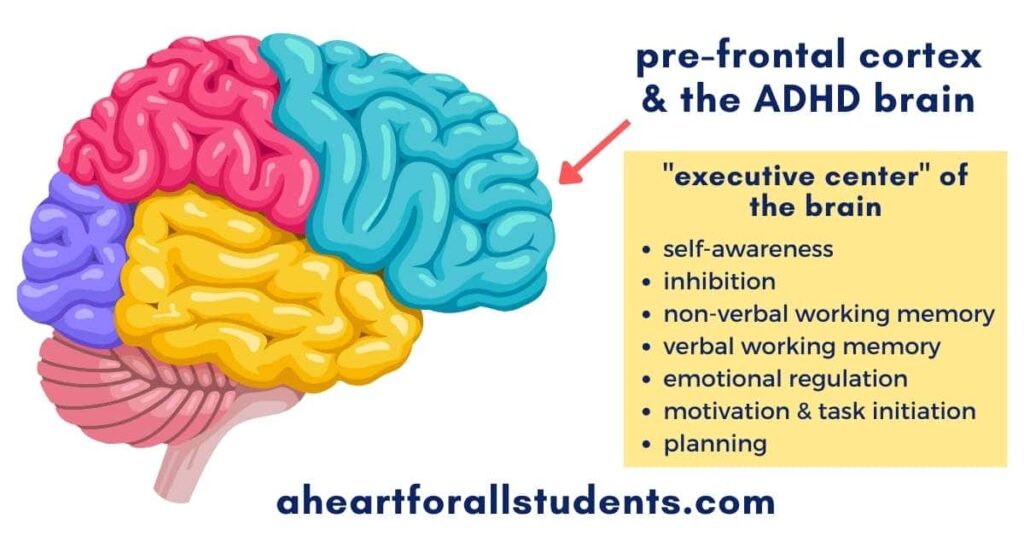Lately, you’ve been hearing about ADHD in women. A few days ago, you heard a mom at playgroup mention she was diagnosed with adult ADHD.
Or perhaps, it was that older lady at the office. Yep. She just got her first official ADHD diagnosis at the age of 51.
On the other hand, maybe you’ve been repeating the same thing for the past six months.
“I’m gonna lose my ever-lovin mind! My to-do list is so long! I’m paralyzed cause I don’t know what to do first!”
You may think there’s no way you can have adult ADHD because you never had trouble in school. Or, maybe you had learning challenges in school, and yet no one helped you.
Regardless of your situation, you’re now looking for information about women with ADHD.
Pin Me for Later!

Friend, I’ve been there myself and was diagnosed at the age of 41. However, today, I’m here specifically for you.
Let’s talk about adult ADHD in women. Also, I’ve made a printable Symptoms of ADHD in Women checklist as a resource to help.
I’m in this with you, Girl. So let’s get started.
This post may contain affiliate links. As an Amazon Associate, I may earn a nominal fee from qualifying purchases. Thank you for your support. See my disclosure policy for more info.
How is This Possible?
The general public tends to think of ADHD in terms of hyper little boys rather than adult women.
And yet both a hyperactive 8-year-old boy and a 40-year-old mom can both have ADHD diagnoses.
Here’s the difference. That hyperactive boy was diagnosed with ADHD in the 2nd grade.
And the mom juggling 3 children?
Like so many adult women, she didn’t even know she had ADHD until adulthood.
That’s when the demands of daily life (parenthood, caring for other family members, and career) outpace her ability to compensate.
While it’s true that boys are diagnosed at more than double the rate of girls in childhood, that’s not the end of the story.
Interestingly, that diagnostic disparity disappears in adulthood when women finally get diagnosed.
Symptoms of Attention Deficit Hyperactivity Disorder
ADHD (Attention Deficit Hyperactivity Disorder) is one of the main childhood neurodevelopmental disorders.
(Neurodevelopmental refers to how the brain functions and develops.)
According to the American Psychiatric Association, there are three main types of ADHD.
- Inattentive ADHD
- Hyperactive-Impulsive ADHD
- Combined Type ADHD
While the three types of ADHD are unique in their list of symptoms, each is impacted by challenges of executive function.
Additionally, the most recent statistical manual of mental disorders (DSM-V) umbrellas the 3 subtypes of ADHD as ADHD.
Further, the DSM-V requires an official diagnosis to indicate severity as either mild, moderate, or severe.
What are Executive Functioning Skills?
Executive Functioning refers to the set of skills that develop over time.
Those executive functioning skills include:
- Following directions
- Sustained attention
- Planning & foresight
- Organization
- Working memory
- Follow-through (perseverance)
- Impulse control
- Ability to self-regulate in a healthy way
- Mental flexibility
Executive functioning skills are controlled by the “executive center” of the brain, the prefrontal cortex. The prefrontal cortex is not fully developed until approximately age 25.

Inattentive Type
Inattentive ADHD is what used to be referred to as ADD, or Attention Deficit Disorder.
Symptoms of inattentiveness include:
- difficulty paying attention
- challenges with paying close attention to detail
- careless mistakes
- trouble completing tasks
- distractability
- forgetfulness
- difficulties following directions
- trouble staying organized
Please note that ADHD is one of the most poorly labeled diagnoses. ADHD has nothing to do with attention deficits.
In fact, ADHD is a problem of “too-much attention” to all things. The ADHD brain is notorious for receiving too much information and having a hard time filtering out unnecessary input.
That leads to symptoms such as overwhelm, distractibility, anxiety-like behaviors, and more.
Hyperactive-Impulsive ADHD
Hyperactive-Impulsive ADHD relates to what we consider the hyperactive type of ADHD. Symptoms include:
- fidgeting
- squirming when seated
- moves around a lot
- a hard time sitting for an extended period of time
- interrupting or blurting things out without thinking
- overall restlessness
Combined-Type ADHD
The combined form of ADHD is related to a combination of the above symptoms of ADHD.
Childhood Diagnosis of ADHD
Childhood ADHD is often noticed when disruptive symptoms start to cause significant problems in the home or classroom.
Early emotional regulation issues such as meltdowns or tantrums may indicate the possible presence of ADHD in preschoolers.
On the other hand, signs of the child’s ADHD brain may not appear until kids enter a traditional school setting.
Once expected to sit, listen, and focus all day, impulsivity problems may cause distractions in the classroom. Ultimately, this may lead to a teacher pushing for an ADHD diagnosis.
As stated previously, the prevalence of ADHD in childhood is far greater in boys who are diagnosed at 3:1 compared to girls. (Some suggest that the ratio is 2:1 boys to girls.)
Why Is ADHD Missed in Girls?
Nothing gets you referred to a psychiatrist faster than being a pain in the (butt)… The girls weren’t getting referred because the girls weren’t obnoxious.
Dr. Russell Barkley, Women with ADHD | Dr. Russell Barkley Interview, Part 3
It’s believed that, in childhood, girls are underdiagnosed with ADHD for several reasons.
- prevalence of inattentive ADHD symptoms
- less outward disruptive behavior (boys have higher rates of oppositional defiant disorder)
- parent and teacher ratings under-reporting ADHD behaviors in girls and rather primarily focusing on boys
- higher rates of compensatory strategies including masking
- sociological gender roles
- ADHD behaviors are often internalized by girls
Undoubtedly, outdated diagnostic criteria based primarily on boys have prevented girls from getting an accurate diagnosis.
Historic Gender Disparity in ADHD
Unfortunately, the gender disparity has been in the DSM, the statistical manual of mental disorders, since ADHD was first included in 1968.
At that time and up until recently, there had been little research on girls with ADHD.
Additionally, girls are consistently unidentified because they generally show symptoms of inattention.
Further, neurodivergent girls are experts in masking.
As such, they’re much less disruptive in class and at home. This contributes to teachers and parents underreporting girls and rather, reporting and associating ADHD with boys.
Undiagnosed ADHD Girls Misdiagnosed
According to Dr. Barkley, scientific research offers clear evidence that ADHD in women and girls needs to be addressed.
He says the longer one goes with untreated ADHD, the greater chances of developing an anxiety disorder.
This he attributes to the perpetual failures (demoralization) that accumulate over time. And a 2018 article by the Anxiety and Depression Society of America reiterates this correlation.
It notes that in the United States, girls are twice as likely to be diagnosed with a mental health disorder.
So, with girls being overlooked for ADHD during childhood and adolescence, what’s happening to them? That’s where things take a harsh turn.
Instead of receiving the support that they need, these girls are often labeled negatively.
Living under societal pressures to be “lady-like”, these undiagnosed girls often struggle when their hyperactive or inattentive symptoms are misunderstood.
Undiagnosed ADHD in girls leads to destructive name-calling. They’re often labeled:
- a space-cadet
- rude
- lazy
- off in her own world
This can lead to low self-esteem and troubles with social interaction and friendships.
Delayed ADHD Treatment Leads to Greater Risks
Eventually, the demands of everyday life overwhelm that young girl to the point that her parents must reach out to a healthcare provider.
However, the news rarely gets better.
Rather than being properly diagnosed with ADHD, she’ll likely be diagnosed with one of many mood disorders.
To Dr. Barkley’s earlier point about delayed diagnosis in girls, most young women will receive a diagnosis before a proper ADHD diagnosis.
Specifically, they may be diagnosed with:
- an anxiety disorder,
- depression,
- or even bipolar disorder
It’s not surprising that undiagnosed ADHD in girls and women is often labeled as an anxiety disorder as both have very similar symptoms.
Stigma, Mental Health Care, & ADHD in Women
If treatment for that mental health condition does not lead to improved quality of life for these young girls, things can get even worse.
At a loss, medical professionals may label undiagnosed ADHD young ladies with one of many personality disorders.
According to ADDitudemag.com, historically undiagnosed ADHD in adult women was often misdiagnosed with Borderline Personality Disorder (BPD).
This leads to further emotional damage considering the stigma associated with such terms.
Further, it’s well known that those with ADHD are more likely to engage in substance abuse.
Even more, substance abuse is greater when there are comorbid diagnoses such as anxiety and depression.
As we’ve seen multiple times already, undiagnosed ADHD in girls leads to anxiety and depression.
At the 2019 ADHD Public Health Summit, it was reported that girls with ADHD are 3.6 times more likely (than girls without ADHD) to struggle with impulsive eating and binge eating.
Further, females with ADHD are almost 6 times more likely to have bulimia.
Female Hormones & ADHD
Interestingly, in February of 2021, Barkley noted a wave of ADHD occurring as girls enter middle school or begin menstruation.
Further, as girls enter high school, a combination of poor self-worth, increased demands in daily tasks, and hormonal changes can lead to further psychological distress.
He believes that the frontal lobe (prefrontal cortex of the brain) is sensitive to female hormonal changes including severe mood swings.
This hormonal change in adolescence is suspected to push girls over the subclinical level of early childhood and into the clinical ADHD level.
To add to the complexity, he notes that in more recent years doctors are seeing another wave of female adult ADHD diagnoses.
Yes. In mid to later life, women begin reaching out to mental health professionals for the first time in their lives.
Again, the theory is that as hormones fluctuate later in life, the prevalence of ADHD increases in women.
ADHD Heritability
ADHD has a high heritability rate of 77-88%.
This means that if you’re the mother of a child with ADHD, there’s a high likelihood that you have ADHD.
Perhaps, like so many other women, you look back and see that you had earlier signs of ADHD in childhood.
You remember being highly distracted in school. Or perhaps you were the girl whose report card always said, “Talks too much.”
You may have been diagnosed with another mental health disorder or related condition as an adolescent.
If you notice similarities between you and your child, you may want to consider an ADHD assessment.
Perhaps, you’re having trouble with…
- Time management,
- ADHD paralysis, or
- Struggle with sleep
- (ADHD and sleep disorders go hand in hand.)
Or, maybe the increased demands of your child’s need for mental health services were manageable at first.
However, like many special needs parents, you’re now having a hard time coping. This was certainly true in my case.
It never hurts to talk with your doctor about the possibility of Adult ADHD.
How Do Adult Women Get a Proper ADHD Diagnosis?
If you’re seeking out an ADHD diagnosis, I recommend you go to a trained mental health professional with expertise in ADHD in women.
While your primary doctor can prescribe you stimulant medications, it’s often not a good idea for the long term. If you have a history of prior mental health diagnoses, this is even more important.
Personally, I’d join an online ADHD support group and ask for ADHD-expert psychiatrist recommendations.
You’re worth the investment and effort, Friend.
Pin Me for Later!

Treatment for ADHD in Women
The treatment for ADHD in women is similar to that when treating ADHD in children.
The Mayo Clinic offers a few treatment options for adult ADHD. Particularly, they recommend the use of stimulant medications.
(Stimulants work by increasing the amount of available dopamine in the ADHD brain.)
- The use of ADHD medication (stimulant medications are the primary form, although, there are non-stimulants for ADHD)
- Education
- Mental health support
While the Mayo Clinic recommends cognitive behavioral therapy, that may not work well if you’re nervous system is highly dysregulated.
Dysregulation often occurs as a result of chronic psychological distress. The relationship between untreated ADHD and trauma is clear.
EMDR for Women with ADHD
Dysregulation is often associated with a chronic state of fight-or-flight (sympathetic arousal) that is very common in ADHD.
EMDR is one of the most highly-effective therapies for trauma-induced dysregulation.
Emotional dysregulation is one of the hallmarks of ADHD. Think about your average week. How often do you feel triggered…
- To the point that your heartbeat rises quickly?
- Chest area feels tight?
- Does your gut feel like it’s in knots?
- Do headaches come on quickly?
- Do you lose your cool on a loved one?
Friend, this is not a choice, but a sign that your nervous system is on guard to protect you.
EMDR helps rewire the circuits in the lower part of your brain responsible for keeping you alive.
Why Safety is Essential for the Brain
For more on the brain and its impact on emotional regulation, learning, and behavior, watch this quick video tutorial.
ADHD Coaching
Another fantastic option for women with ADHD is to seek out an ADHD coach or support group.
ADHD coaches are a great resource to guide you as you begin to incorporate your understanding of ADHD into your daily lifestyle.
ADHD Coaches International is a great resource with a network of coaches for Canadian and US residents.
Nutrition, Quality Supplementation, & Exercise
As mentioned earlier, stimulant medications are effective because of they increase available dopamine in the brain. Fortunately, there are ways you can increase dopamine naturally.
Some other ways to support your ADHD brain can include paying closer attention to the following.
- Nutrition,
- Quality supplementation,
- Adding in some form of daily exercise
This does NOT mean that ADHD symptoms will be completely resolved with nutrition, vitamins, and exercise.
However, they’re an excellent piece of the overall mental and physical health puzzle.
In our ADHD home, we include BrainMD brain health supplements every day. Dr. Daniel Amen is an expert in brain health and I trust his products.
ADHD in Women Symptoms and Signs
To give a better idea of the symptoms that ADHD women experience, I’ve put together an ADHD in Women Checklist. I’ve compiled these symptoms and signs based off:
- Years of my own reading and research,
- My personal experience,
- Polling A Heart for All Students community online,
- Collecting anecdotal data from other women who’ve shared their stories,
- as well as from the National Institue of Mental Health and the Mayo Clinic,
- ADHD Advocacy groups such as CHADD and ADDitude Magazine
ADHD in Women Checklist (PDF Download)
I’ve broken down these signs and symptoms of ADHD in women into 4 categories.
Specifically, I’ve included a section based on Dr. Russell Barkley’s emphasis on Emotional Regulation in ADHD.
Further, I’ve included a section that highlights the reality that the ADHD brain receives an overabundance of sensory input.
Impulsivity and Hyperactivity
- Extra talkative
- Blurting out or interrupting
- Overcommitted
- Make plans and then want to cancel the day of
- Oversharing
- Binge eating
- Overwhelmed by the needs of others
- Compulsively clean or do random mindless projects when overwhelmed
- Skin picking around nails
- Knee shaking
- Bite inside of lip
- Finger tapping
- Nail flicking
- Bursts of energy followed by complete loss of energy
- Fidgeting when seated
- Have to get up and move around during church service or other meetings
- Sleep disorders or disrupted sleep
Disorganization and Inattention
- Doom piles
- General disorganization
- Messy purse, car, home, etc
- Troubles with time management
- Constantly playing catch up
- Frantically search for things that you just saw “two seconds ago”
- Object blindness
- History of being called “Spacey,” “Rude”, “Checked out”
- Told you make “careless” mistakes
- Daydreaming
- Task Initiation (getting started on projects)
- Difficulties completing projects
- Struggle with transitions (come home end up raiding the fridge)
- Zone out in convos
- Challenges with sustained attention
Emotional Regulation
- Called “overly emotional”
- Frustrated often or easily
- Withdraws when overwhelmed or done
- Struggle w self-esteem
- Moody (cranky, rages, irritability)
- Labeled “too sensitive
- Rejection sensitivity dysphoria
- Anxious
- Imposter syndrome
- Feeling less than
- Chronic stress (putting out fires)
- Being “done” by the middle or end of the day
- Feeling lazy (never enough)
- Avoiding friendships
- Hide or “on lockdown” when feeling overwhelmed
Too Much Attention & Sensory Processing
- Paralysis when to much to do
- Time blindness
- Hyperfocus
- Appear unmotivated
- Always late or always early
- Hates hair touching face
- Sensory sensitive with clothes, sounds, smells, etc.
- Grind or clench teeth
- Visual cluster stresses you out
- Overwhelmed in crowded places (hate stores or shopping)
- Clumsy or accidentally break or drop things
Please remember that this list is not exhaustive and not for diagnostic use. See a qualified mental health professional for an official diagnosis.
This post may contain affiliate links. As an Amazon Associate, I may earn a nominal fee from qualifying purchases. Thank you for your support. See my disclosure policy for more info.











Lindsay, THANK YOU! You are SUCH a BLESSING!! This post resonates with me SO MUCH, and it gives me the answers I’ve been looking for for decades! God BLESS you!!!
Oh, Carrie, Thank you so much for sharing with me. I’m so glad the Adult ADHD in Women symptoms checklist was resonates. Yay for you!!! It’s such a journey, Friend. We’re in it together. If you want to dive in a bit more, check out this list of fun “signs of adult ADHD”… https://aheartforallstudents.com/adhd-checklist-adults/